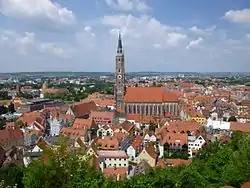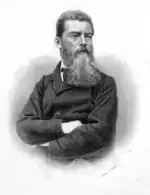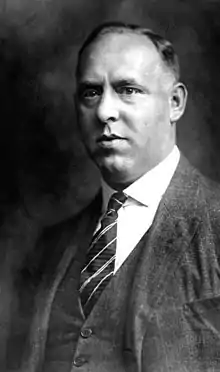Landshut
Landshut (German: [ˈlant͡shuːt] (![]() listen);[2] Bavarian: Landshuad) is a town in Bavaria in the south-east of Germany. Situated on the banks of the River Isar, Landshut is the capital of Lower Bavaria, one of the seven administrative regions of the Free State of Bavaria. It is also the seat of the surrounding district, and has a population of more than 70,000. Landshut is the largest city in Lower Bavaria, followed by Passau and Straubing, and Eastern Bavaria's second biggest city.
listen);[2] Bavarian: Landshuad) is a town in Bavaria in the south-east of Germany. Situated on the banks of the River Isar, Landshut is the capital of Lower Bavaria, one of the seven administrative regions of the Free State of Bavaria. It is also the seat of the surrounding district, and has a population of more than 70,000. Landshut is the largest city in Lower Bavaria, followed by Passau and Straubing, and Eastern Bavaria's second biggest city.
Landshut | |
|---|---|
 Town centre with St. Martin's Church | |
 Coat of arms | |
Location of Landshut 
| |
 Landshut  Landshut | |
| Coordinates: 48°32′23″N 12°09′03″E | |
| Country | Germany |
| State | Bavaria |
| Admin. region | Lower Bavaria |
| District | Urban district |
| Founded | 1204 |
| Government | |
| • Mayor | Alexander Putz (FDP) |
| Area | |
| • Total | 65.7 km2 (25.4 sq mi) |
| Elevation | 445 m (1,460 ft) |
| Population (2019-12-31)[1] | |
| • Total | 73,411 |
| • Density | 1,100/km2 (2,900/sq mi) |
| Time zone | UTC+01:00 (CET) |
| • Summer (DST) | UTC+02:00 (CEST) |
| Postal codes | 84001-84036 |
| Dialling codes | 0871 |
| Vehicle registration | LA |
| Website | www.landshut.de |
Owing to its characteristic coat of arms, the town is also often called "City of the three Helmets" (German: Dreihelmenstadt). Furthermore, the town is popularly known for the Landshuter Hochzeit (Landshut Wedding), a full-tilt medieval festival.
Due to its proximity and easy access to Munich and the Franz Josef Strauss International Airport, Landshut became a powerful and future-oriented investment area. The town is one of the richest industrialized towns in Bavaria and has East Bavaria's lowest unemployment rate.
Geography
Settings
Landshut lies in the centre of Lower Bavaria, and is part of the Alpine foothills. The River Isar runs through the city centre. Landshut is about 72 kilometres (45 mi) northeast of Munich.
History
The city of Landshut and Trausnitz castle were founded in 1204 by Duke Louis I. Landshut was already a Wittelsbach residence by 1231, and in 1255, when the duchy of Bavaria was split in two, Landshut also became the capital of Lower Bavaria. Duke Henry XVI was the first of the three famous rich dukes who ruled Bayern-Landshut in the 15th century. The wedding of Duke George with the Polish Princess Royal Jadwiga Jagiellon in 1475 was celebrated in Landshut with one of the most splendid festivals of the Middle Ages (called "Landshuter Hochzeit"). After his death and the Landshut War of Succession, Bavaria-Landshut was reunited with Bavaria-Munich.
Louis X, Duke of Bavaria built the Landshut Residence 1537–1543 after his visit to Italy. Louis built the first Renaissance palace constructed north of the Alps after the Palazzo Te in Mantua. William V, Duke of Bavaria ordered to upgrade Trausnitz Castle from a gothic fortification into a renaissance complex when he lived in Landshut as crown prince for ten years until 1579. Afterwards Landshut lost most of its importance until the University of Ingolstadt was moved to Landshut in 1800. But already in 1826 the university was transferred to Munich.
In 1634, during the Thirty Years' War, the city was taken and plundered by Swedish forces under the command of Bernard of Saxe-Weimar.[3]
Napoleon fought and won the Battle of Landshut in 1809 against an Austrian army as part of the War of the Fifth Coalition.
During World War II, a subcamp of Dachau concentration camp was located in the city to provide slave labour for local industry.
The U.S. Army maintained facilities in Landshut, including Pinder Kaserne and a dependent housing area, until 1968.
Since the opening of Munich Airport close to Landshut in 1992, the town has become an attractive business location.
| Largest groups of foreign residents | |
| Nationality | Population (2013) |
| 1,275 | |
| 911 | |
| 730 | |
| 532 | |
| 407 | |
| 345 | |
Main sights and culture

The town is of national importance because of its predominantly Gothic architecture within the historic town centre, especially Trausnitz Castle and the Church of Saint Martin featuring the world's tallest brick tower. Among other Gothic architecture are the churches of St. Jodok and Holy Spirit, but also the Town Hall and the Ländtor, the only still existing gate of the medieval fortification.
Landshut is also known for a festival celebrated every four years called the Landshuter Hochzeit, commemorating the 1475 marriage of George of Bavaria and Jadwiga Jagiellon.
The renaissance era produced in particular the decorated inner courtyard of the Trausnitz Castle and the ducal Landshut Residence in the inner town. Baroque churches are represented by the Jesuit church St. Ignatius, the Dominican church St. Blasius and the church of St. Joseph. Also the medieval churches of the Seligenthal convent and of the Cistercians were redesigned in baroque style. Many old middle-class houses of the past in the Old Town still represent the history of the town from the Gothic times to the Neo-Classicism.
Transportation
There are regular regional train connections to Munich, Passau, Salzburg, Rosenheim, Nuremberg and Hof.
Gallery
 The Cathedral of St. Martin with its bell tower
The Cathedral of St. Martin with its bell tower The Church of St. Jodok
The Church of St. Jodok Redemption church
Redemption church The Landshut Wedding and the Church of the Holy Spirit
The Landshut Wedding and the Church of the Holy Spirit Church of the Holy Ghost, Gothic porch
Church of the Holy Ghost, Gothic porch The Ländtor
The Ländtor The Trausnitz castle
The Trausnitz castle Landshut City View
Landshut City View Town hall
Town hall Old town
Old town Alstadt St, the pedestrian area
Alstadt St, the pedestrian area
Theatres
- Stadttheater (city theatre)
- Kleines Theater
- Theater Nikola
Cinemas
- Kinoptikum – repertory cinema
- Kinopolis Landshut – Multiplex cinema
- Burgtheater/Kühlhauskino
Museums
- Skulpturenmuseum im Hofberg (Sculptural Museum in Hofberg)
- LANDSHUTmuseum in the cloister of the old Franciscan monastery[4]
Venues
- Eisstadion am Gutenbergweg – Indoor Ice hockey arena, mainly used by the Landshut Cannibals
- Sparkassen-Arena – Mainly used for concerts and fairs
- Grieserwiese – Giant parking area located between Wittstraße and the bank of the river Isar used for the annual Frühjahrs- und Bartlmädult
Businesses
- BMW
- Dräxlmaier Group
- Deutsche Telekom
- ebmpapst
- LFoundry, a semiconductor fab formerly owned by Renesas and before by Hitachi)
- Schott Glass
- Vishay
- Karstadt
- de:Pöschl Tabak
There are also two nuclear power plants located 14 km away from Landshut, Isar I (Inactive) and Isar II (active until 2022).
International relations
Twin towns – sister cities
Landshut is twinned with:
|
Notable people
Before 1900

- Ulrich Füetrer (born before 1450; died around 1493 and 1502), poet and painter
- Ludwig Feuerbach (1804–1872), philosopher
- Friedrich Feuerbach (1806–1880), philologian and philosopher
- Gustav Tiedemann (1808–1849), officer
- Carl du Prel (1839–1899), philosopher, writer and occultist
- Karl Tanera (1849–1904), officer of the Bavarian Army and author
- Max Slevogt (1868–1932), painter, graphician
- Otto Kissenberth (1893–1919), fighter pilot in World War I
1901–1950

- Hermann Erhardt (1903–1958), actor
- Max Schäfer (1907–1990), football player- and trainer
- Marlene Neubauer-Woerner (1918–2010), sculptor
- Josef Deimer (born 1936), politician and Lord mayor of Landshut from 1970–2014
- Roman Herzog (1934–2017), politician (CDU), President of Germany from 1994 to 1999, then Honorary Citizen as well
1951–present
- Klaus Auhuber (born 1951), ice hockey player
- Albert Sigl (born 1953), author
- Gerhard Tausche (born 1958), archivar and author
- Gerd Truntschka (born 1958), ice hockey player
- Martin Bayerstorfer (born 1966), politician
- Alex Holzwarth (born 1968), drummer
- Wolfgang Stark (born 1969), FIFA referee
- Markus Brunnermeier (born 1969), financial economist
- Annette Dytrt (born 1983), figure skater
Honorary citizens
- Hans Leinberger (1475/1480-after 1531), sculptor
- Ludwig Andreas Feuerbach, (1804–1872), philosopher and anthropologist
- Roman Herzog (born 1934), President of Germany 1994–1999
- Josef Deimer (born 1936), Lord Mayor of Landshut 1970–2004
- Erich Kühnhackl (born 1950), former ice hockey player
Notable inhabitants of Landshut

- Louis I, Duke of Bavaria (1173–1231), Duke of Bavaria and Count Palatine of the Rhine
- Hans von Burghausen (born 1350–1360; died 1432), builder
- Hans Stethaimer (1360–1432), architect, mason and painter
- Hans Leinberger (1480–1531), sculptor of the late Gothic
- Götz von Berlichingen (1480–1562), Frankish Empire Knights
- Renata of Lorraine (1544–1602), Duchess of Bavaria
- Johann Graf von Aldringen (1588–1634), commander
- Franz von Paula Schrank (1747–1835), botanist
- Johann Michael Sailer (1751–1832), a Catholic theologian and bishop of Regensburg
- Franz Xaver Witt (1834–1888), church musician, composer, reformer, founder of the German general Cecilia Association
- Max Freiherr von Oppenheim (1860–1946), diplomat, orientalist and archaeologist
- Ludwig Thoma (1867–1921), writer
- Hans Carossa (1878–1956), doctor, known as a poet and writer of short stories
- Gregor Strasser (1892–1934), National Socialist politician
- Heinrich Himmler (1900–1945), National Socialist politician, head of the SS
- Marlene Neubauer-Woerner (1918–2010), sculptress
- Fritz Koenig (1924–2017), sculptor
- Heinz Winbeck (born 1946), composer
- Erich Kühnhackl (born 1950), hockey player
- Tom Kühnhackl, professional ice hockey player
- David Elsner, professional ice hockey player
- Herbert Hainer (born 1954), Manager
- Steffen Kummerer (born 1985), musician, guitarist of Obscura
See also
- Battle of Abensberg, occurred 20 April 1809
- Battle of Landshut, occurred 21 April 1809
- Battle of Eckmühl, occurred 21–22 April 1809
- Abensberg
- Eckmühl
References
- "Tabellenblatt "Daten 2", Statistischer Bericht A1200C 202041 Einwohnerzahlen der Gemeinden, Kreise und Regierungsbezirke". Bayerisches Landesamt für Statistik und Datenverarbeitung (in German). July 2020.
- "Landshut". Dictionary.com Unabridged. Random House.
- Helfferich, Tryntje, The Thirty Years War: A Documentary History (Cambridge, 2009), pp. 274-302.
- "Besucherinfo - Museen der Stadt Landshut" (in German).
External links
| Wikimedia Commons has media related to Landshut. |
 Landshut travel guide from Wikivoyage
Landshut travel guide from Wikivoyage- Chisholm, Hugh, ed. (1911). . Encyclopædia Britannica (11th ed.). Cambridge University Press.
- http://www.landshut.de – Official website
- (in German) http://www.fh-landshut.de/
